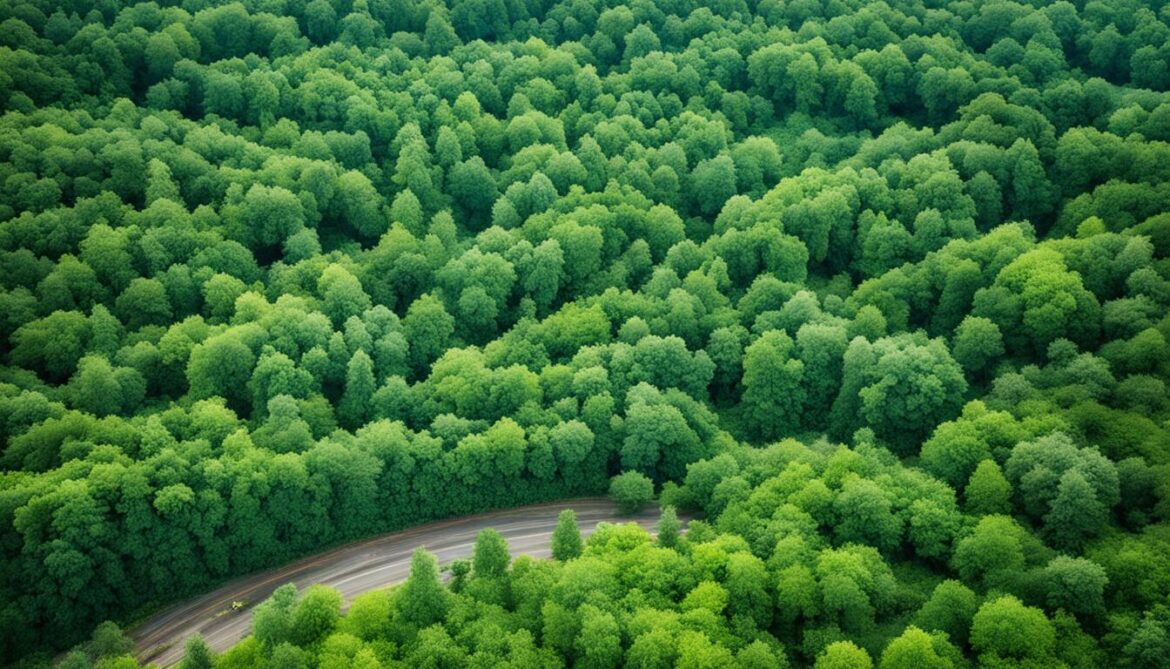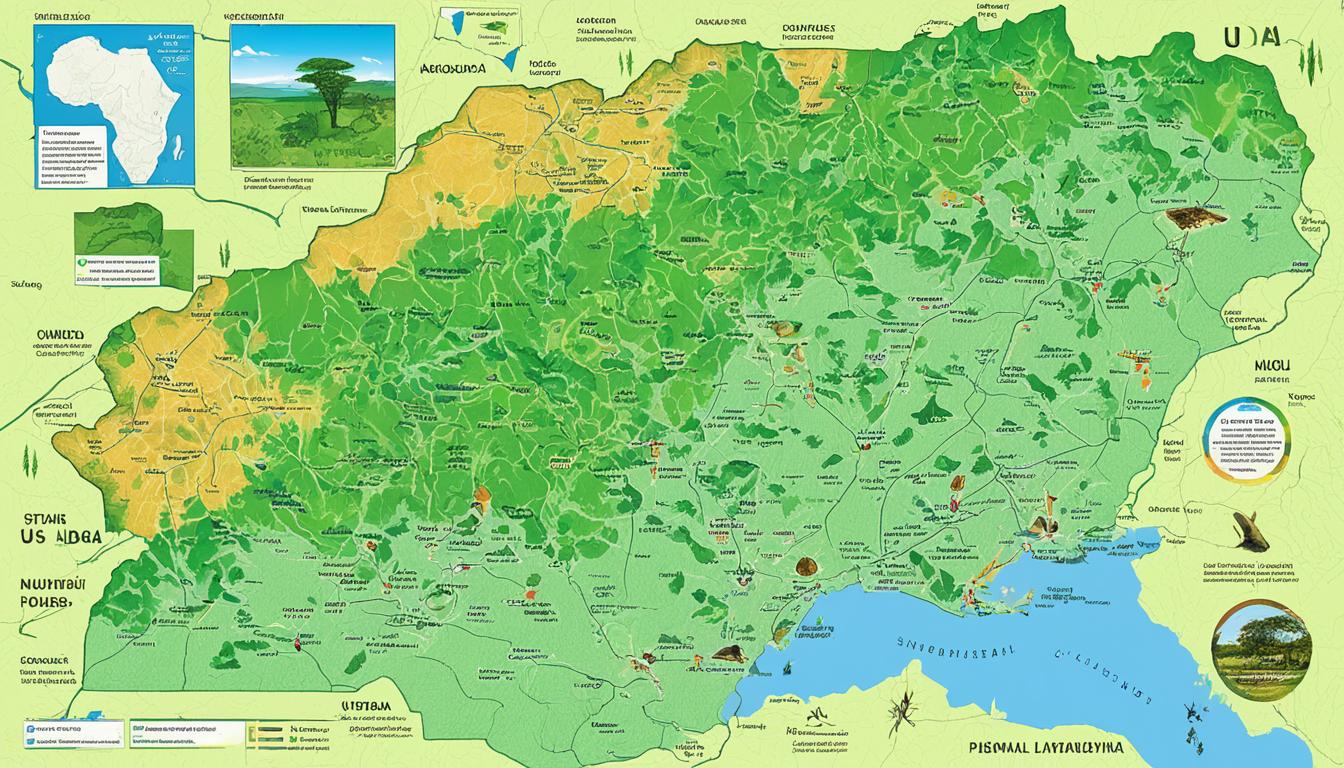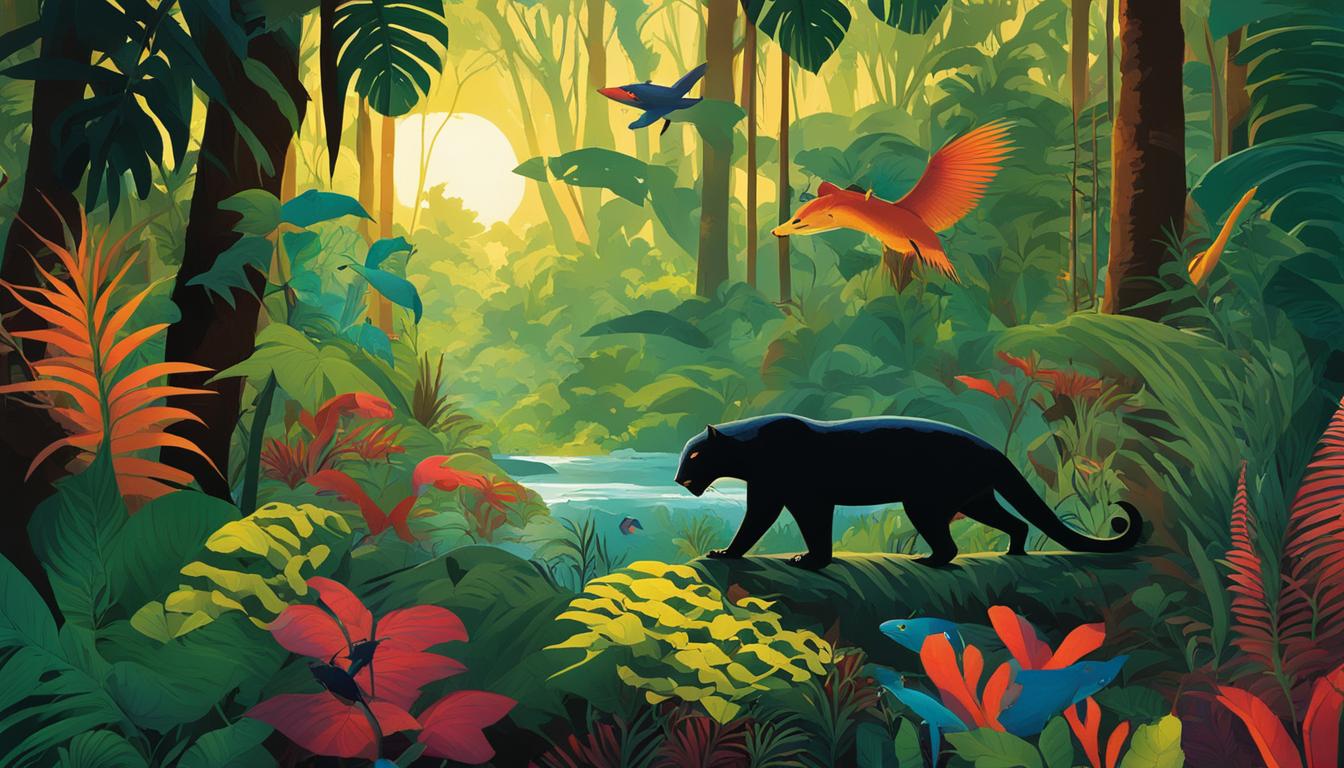Ukraine Biodiversity: Animal and Plant Species and What Is Under Threat
Did you know that Ukraine is home to over 70 thousand species of plants and animals? That’s an impressive number, showcasing the rich biodiversity that exists within the country. However, this biodiversity is under threat from various factors, including anthropogenic activity, climate change, and the impact of the war. In this article, we will explore the incredible diversity of Ukraine’s nature, the challenges it faces, and the measures being taken to protect and preserve its precious wildlife.
Key Takeaways:
- Ukraine is home to over 70 thousand species of plants and animals.
- Anthropogenic activity and climate change pose significant threats to biodiversity in Ukraine.
- The war in Ukraine has had a devastating impact on the environment and wildlife.
- Biodiversity conservation efforts are underway, but there are challenges in implementation and monitoring.
- Urgent action is needed to protect and restore Ukraine’s precious natural heritage.
Ukraine’s Rich Ecosystems
Ukraine boasts a remarkable diversity of ecosystems, despite its relatively small size. Situated at the crossroads of migration paths for numerous animal species, the country enjoys a rich biodiversity. With 377 objects identified in the Emerald network, Ukraine has made significant strides in biodiversity conservation. The Carpathian region is home to extensive primary forests and old-growth forests, adding to the ecological diversity of the nation. However, challenges persist, such as a high percentage of plowed land and a forest area that falls below the European average. In the steppe zone, only a small fraction of natural steppe ecosystems have been preserved.
The Emerald Network
The Emerald network is an initiative of the Council of Europe aimed at protecting areas of particular ecological importance across European countries. The network promotes the conservation of natural habitats and species-rich areas, ensuring their preservation for future generations. Ukraine’s commitment to this network underscores its dedication to ecological diversity and biodiversity conservation. By identifying and safeguarding these precious natural areas, Ukraine plays a vital role in the wider European effort to protect and preserve our shared natural heritage.
| Ecosystem Type | Description |
|---|---|
| Forests | Ukraine boasts extensive primary forests and old-growth forests, providing essential habitat for numerous plant and animal species. |
| Wetlands | The country is home to a variety of wetland ecosystems, including marshes, bogs, and swamps, which support unique flora and fauna. |
| Steppe | The steppe zone of Ukraine is characterized by vast grasslands teeming with diverse plant species and providing habitat for a range of animal species. |
| Aquatic | Ukraine’s water bodies, including rivers, lakes, and the Black Sea, harbor a rich variety of aquatic life, contributing to the nation’s ecological diversity. |
The diverse ecosystems found in Ukraine are invaluable, supporting a wide array of flora and fauna. Protecting and preserving these ecosystems is essential for the long-term well-being of both the environment and future generations. By implementing effective conservation strategies, Ukraine can ensure the sustainability of its ecological diversity and contribute to global efforts in biodiversity conservation.
Threats to Ukraine’s Biodiversity
Ukraine’s remarkable biodiversity is facing several significant threats that endanger the country’s ecosystems and require urgent attention for conservation efforts. The destruction and transformation of habitats emerge as one of the primary challenges. With a high percentage of plowed land and a low forest area, Ukraine experiences a loss of biodiversity due to habitat degradation.
Furthermore, poaching activities and the proliferation of invasive species pose substantial threats to Ukraine’s fragile ecosystems. Poaching disrupts the natural balance and puts endangered species at even greater risk. The increase in invasive species threatens the native flora and fauna, as they outcompete and displace indigenous organisms.
Climate change exacerbates the challenges faced by Ukraine’s biodiversity. The drying of pine plantations, for example, significantly impacts the ecosystem’s stability and hinders species’ survival. The higher risk of forest fires adds further pressure on the already fragile biodiversity of Ukraine.
While there are measures in place for biodiversity conservation and environmental education, the execution and monitoring of these initiatives face significant obstacles. Ensuring effective implementation and assessment of conservation measures are crucial to safeguarding Ukraine’s endangered species and preserving its unique ecosystems in the face of these threats.
Conservation Efforts in Ukraine
Biodiversity conservation in Ukraine is an integral part of the country’s commitment to preserving its ecological diversity and protecting the rich flora and fauna of Ukraine. A comprehensive national program for biodiversity preservation, spanning from 2005 to 2025, guides conservation efforts and aims to safeguard Ukraine’s natural heritage.
As a signatory to various international conventions for environmental protection, Ukraine is actively engaged in global efforts to conserve biodiversity. These conventions create frameworks for cooperation, knowledge sharing, and coordinated action in addressing biodiversity loss and promoting sustainable development.
One of the key pillars of biodiversity conservation in Ukraine is the establishment and management of protected areas. These areas play a critical role in preserving the country’s unique ecosystems, providing safe havens for rare and endangered species, and maintaining ecological balance.
Currently, approximately 7% of Ukraine’s territory is included in the nature reserve fund, protecting diverse habitats such as forests, wetlands, and grasslands. These protected areas serve as invaluable ecological sanctuaries and contribute to the overall sustainability of Ukraine’s natural environment.
Protected Areas in Ukraine
| Category | Number of Protected Areas | Total Area (hectares) |
|---|---|---|
| Nature Reserves | 87 | 1,480,365 |
| National Parks | 18 | 810,240 |
| Landscape Reserves | 366 | 260,356 |
| Biosphere Reserves | 8 | 1,766,156 |
Source: State Agency of Forest Resources of Ukraine
In addition to domestic efforts, Ukraine is actively participating in international initiatives for biodiversity conservation. The country is part of the Emerald Network, a network of protected areas established under the Bern Convention. Through this network, Ukraine collaborates with other European countries to ensure the conservation and sustainable management of habitats and species of European significance.
Furthermore, Ukraine is working towards aligning its biodiversity conservation practices with European Union legislation. This alignment aims to promote harmonization, effective governance, and greater transparency in Ukraine’s efforts to protect and restore its ecological diversity.
Despite these commendable efforts, biodiversity conservation in Ukraine faces several challenges. Adequate financing, staffing, and the establishment of comprehensive management plans for protected areas are crucial for long-term conservation success. Additionally, addressing illegal practices such as poaching and effectively managing human-wildlife conflicts require continued attention and collaboration.
However, with ongoing dedication and collective action, Ukraine can continue to protect and preserve its remarkable natural resources, ensuring the sustainable future of its flora and fauna for generations to come.

Impact of the War on Ukraine’s Biodiversity
The war in Ukraine has had a devastating impact on the environment and biodiversity. According to the Ministry of Environmental Protection and Natural Resources, 20% of protected areas and numerous animal and plant species have been affected. The destruction of crucial ecosystems, deforestation, and forest fires have all contributed to the loss of biodiversity.
Marine life, such as dolphins, has also been disturbed by the war, resulting in mass strandings on Black Sea beaches. Rehabilitation efforts will be required to restore damaged areas.

Unfortunately, the war has taken a toll on Ukraine’s rich biodiversity. The destruction caused by conflict directly impacts the delicate balance of ecosystems and threatens the survival of various plant and animal species. The loss of protected areas not only disrupts natural habitats but also leads to the decline of endangered species that rely on these areas for survival.
Furthermore, deforestation associated with the conflict exacerbates the loss of biodiversity. Forests act as vital habitats for many species, providing food, shelter, and nesting grounds. The destruction of forests not only eliminates these crucial habitats but also disrupts the entire ecosystem’s functioning.
“The war in Ukraine has resulted in significant damage to the environment and biodiversity. The destruction of habitats and ecosystems has had a catastrophic impact on plant and animal species. Urgent action is needed to restore damaged areas and protect the remaining biodiversity.” – Ministry of Environmental Protection and Natural Resources
The war has also intensified forest fires in Ukraine, further endangering biodiversity. These fires not only harm the flora and fauna directly but also contribute to climate change and subsequent ecosystem disruptions. Increased temperatures and altered precipitation patterns create an unfavorable environment for many species, leading to population declines or even local extinctions.
The impact of the war is not limited to terrestrial ecosystems. Marine life, such as dolphins, has been disturbed by the conflict, resulting in mass strandings along the Black Sea coast. Disturbances in their natural habitats and increased human activity in coastal regions disrupt the feeding and breeding patterns of marine species, ultimately affecting their survival.
Impact of the War on Ukraine’s Biodiversity
| Effects | Description |
|---|---|
| Destruction of Ecosystems | The war has led to the destruction of crucial ecosystems, including forests, wetlands, and grasslands, which are home to diverse plant and animal species. |
| Loss of Protected Areas | Approximately 20% of Ukraine’s protected areas have been affected by the conflict, disrupting vital habitats and threatening the survival of endangered species. |
| Deforestation | Deforestation is a direct consequence of the war, leading to the loss of important habitats and affecting the ecosystem balance. |
| Forest Fires | The conflict has contributed to an increase in forest fires, which further harm biodiversity and contribute to climate change. |
| Disturbance of Marine Life | The war has disturbed marine ecosystems, resulting in mass strandings of marine species, such as dolphins, along the Black Sea coast. |
Rehabilitation efforts will be crucial in restoring Ukraine’s damaged ecosystems and protecting the remaining biodiversity. This will require the collaboration of local communities, environmental organizations, and the government to implement conservation initiatives, create protected areas, and promote sustainable practices.
The preservation and restoration of Ukraine’s biodiversity are essential not only for the country but also for the global ecosystem. By protecting and nurturing Ukraine’s unique wildlife and ecosystems, we contribute to the overall conservation of the planet’s biodiversity.
Measures for Environmental Protection
Ukraine has taken significant steps towards environmental protection and biodiversity conservation in the country. The National Biodiversity Strategy and Action Plan highlight the importance of preserving and restoring ecosystems as well as safeguarding species and populations. Efforts have been made to optimize urban landscapes, agricultural practices, and forestry management, ensuring sustainable development.
The development of national ecological networks serves as a crucial strategy to enhance connectivity between different habitats, facilitating the movement of species and promoting biodiversity. Additionally, the expansion of the nature reserve fund has led to the protection of significant areas and habitats, safeguarding valuable flora and fauna.
However, despite these efforts, there is a pressing need for increased funding, capacity-building, and coordination to effectively implement these measures. Sustainable financing models and support mechanisms should be established to ensure the long-term success of environmental protection initiatives in Ukraine.

Optimizing Urban Landscapes
Urban areas play a vital role in biodiversity conservation. By implementing sustainable urban planning and design, cities can provide habitats for a wide range of species and enhance biodiversity within their boundaries. Parks, green spaces, and vertical gardens contribute to wildlife habitats and promote a healthier environment in urban settings. Adopting environmentally friendly practices, such as reducing pollution and promoting sustainable transportation, further supports the conservation of biodiversity in urban areas.
Agricultural Practices and Forestry Management
The agricultural sector has a significant impact on biodiversity in Ukraine. Implementing sustainable farming practices, such as organic farming and agroforestry, can minimize the detrimental effects of conventional agriculture on ecosystems and support biodiversity conservation. Similarly, sustainable forest management practices, including reforestation, selective logging, and habitat restoration, are crucial for maintaining healthy forest ecosystems and preserving biodiversity.
The Importance of National Ecological Networks
National ecological networks are essential for enhancing the connectivity of habitats and promoting the movement of species across different landscapes. By establishing corridors and buffer zones, these networks facilitate gene flow, reduce the risk of isolation for populations, and support the long-term survival of species. Strengthening the development and management of national ecological networks is vital for ensuring the conservation and sustainable use of biodiversity in Ukraine.
Monitoring and Reviewing Implementation
Ukraine prioritizes the implementation of effective monitoring and review mechanisms to ensure the success of biodiversity conservation efforts across the country. Various programs for biodiversity monitoring have been established, with a particular focus on assessing phytodiversity and animal species. These monitoring activities significantly contribute to the understanding of the country’s ecological diversity and aid in the development of targeted conservation strategies.
However, it is important to note that monitoring programs are currently concentrated in specific regions, primarily in Western and Southern Ukraine. To achieve comprehensive coverage and a holistic understanding of biodiversity trends nationwide, it is crucial to expand monitoring efforts to encompass diverse ecological zones.
Funding for biodiversity conservation activities primarily comes from the state budget, supplemented by support from technical cooperation programs. This ensures that monitoring and review initiatives can be adequately resourced and sustained over time.
In line with global targets and commitments, Ukraine is currently revising its National Biodiversity Strategy and Action Plan. This revision aims to align the country’s conservation efforts with international best practices and ensure the implementation of effective and evidence-based biodiversity conservation strategies.
| Focus Areas | Monitoring Programs |
|---|---|
| Phytodiversity | Botanical surveys and vegetation assessments |
| Animal species | Ecological surveys, population studies, and tracking programs |
Expanding Monitoring Efforts
To ensure a comprehensive understanding of Ukraine’s ecological diversity, it is essential to expand biodiversity monitoring initiatives to cover all regions of the country. This includes prioritizing monitoring efforts in the following areas:
- Steppe ecosystems
- Wetlands and marshes
- Forests and woodlands
- Mountainous regions
By expanding monitoring activities to these ecological zones, Ukraine can gather more accurate and representative data on the state of its biodiversity and make informed decisions regarding conservation priorities and strategies.
Effective monitoring and review mechanisms are vital for safeguarding Ukraine’s ecological diversity. By gathering reliable data and assessing the effectiveness of conservation efforts, we can ensure that our natural heritage is conserved for future generations to enjoy.

Support Mechanisms for Implementation
Ukraine has various support mechanisms in place to facilitate the implementation of biodiversity conservation measures. Funding for conservation activities is derived from the state budget, with additional support from technical cooperation programs. The Ministry of Environmental Protection collaborates with scientific institutions and local organizations in the field of biodiversity conservation. However, there is a need for increased funding and capacity-building to effectively implement and sustain these support mechanisms.
One of the key support mechanisms for biodiversity conservation in Ukraine is the allocation of funds from the state budget. These funds are dedicated to various conservation efforts, including the establishment and management of protected areas, habitat restoration projects, and species conservation initiatives. Additionally, technical cooperation programs provide supplementary funding and expertise to support biodiversity conservation activities in the country.
The Ministry of Environmental Protection plays a crucial role in coordinating and collaborating with scientific institutions and local organizations. Through partnerships with universities, research institutes, and non-governmental organizations, the ministry facilitates the exchange of knowledge, expertise, and resources for effective biodiversity conservation. These collaborations help to enhance research and monitoring efforts, develop conservation strategies, and implement on-the-ground conservation actions.
Despite the existing support mechanisms, there is a need for increased funding and capacity-building to address the challenges faced in implementing and sustaining biodiversity conservation measures in Ukraine. Additional financial resources can enable the expansion of conservation projects, the recruitment and training of skilled personnel, and the implementation of comprehensive conservation plans. Capacity-building efforts, such as providing training opportunities and technical assistance, can enhance the skills and knowledge of conservation practitioners, enabling them to address conservation challenges more effectively.
In conclusion, the support mechanisms currently in place in Ukraine offer valuable resources and collaboration opportunities for biodiversity conservation. However, increased funding and capacity-building are necessary to ensure the successful implementation and long-term sustainability of conservation measures. By prioritizing and investing in biodiversity conservation, Ukraine can make significant progress in protecting its unique nature and wildlife for future generations.

The Need for Action
The current threats to biodiversity conservation in Ukraine require urgent action. It is essential for the government to prioritize the conservation of biodiversity and provide sufficient support for measures such as biodiversity monitoring, habitat restoration, and the establishment of protected areas. Additionally, measures to mitigate the impacts of climate change on biodiversity should be implemented. Citizens can also play a role by advocating for biodiversity conservation and supporting initiatives and organizations working towards preservation and restoration efforts.
Conclusion
Ukraine’s natural heritage is a treasure trove of biodiversity, boasting unique ecosystems and a diverse array of plant and animal species. However, the country faces multiple challenges that threaten its valuable biodiversity. Anthropogenic activities, climate change, and the devastating impact of the war have all taken a toll on Ukraine’s natural environment.
Despite these challenges, Ukraine has implemented conservation efforts to protect its biodiversity. However, there is a pressing need for stronger implementation and monitoring of these measures. It is vital for the government, organizations, and citizens to come together and prioritize the conservation of Ukraine’s unique natural resources.
By providing support for initiatives, advocating for biodiversity conservation, and taking action to protect and restore key habitats, we can all play a crucial role in preserving Ukraine’s natural heritage for future generations. Let us join hands to safeguard Ukraine’s biodiversity, cherish its natural wonders, and ensure the survival of its enchanting wildlife.
FAQ
What is biodiversity?
Biodiversity refers to the variety of life forms on Earth, including plants, animals, and microorganisms, as well as the ecosystems they inhabit.
How many species of plants and animals are there in Ukraine?
Ukraine is home to over 70 thousand species of plants and animals.
What are the main threats to biodiversity in Ukraine?
The main threats to biodiversity in Ukraine include the destruction and transformation of habitats, poaching, the increase in invasive species, and the impacts of climate change.
What is being done to conserve biodiversity in Ukraine?
Ukraine has a biodiversity conservation policy in place, and efforts are being made to establish protected areas, implement monitoring programs, and promote environmental education and awareness.
How has the war in Ukraine affected the environment and biodiversity?
The war in Ukraine has had a devastating impact on the environment and biodiversity, leading to the destruction of crucial ecosystems, deforestation, and the disturbance of marine life.
What measures are in place for environmental protection in Ukraine?
Ukraine has implemented various measures for environmental protection, including the development of national strategies and action plans, optimization of land use practices, and the expansion of protected areas.
How is the implementation of biodiversity conservation measures monitored?
Ukraine has mechanisms in place for monitoring and reviewing the implementation of biodiversity conservation measures, including various monitoring programs and funding from the state budget and technical cooperation programs.
What support mechanisms are available for the implementation of biodiversity conservation measures?
Ukraine has various support mechanisms in place, including funding from the state budget, collaboration with scientific institutions and local organizations, and capacity-building initiatives.
What is the current need for action to conserve biodiversity in Ukraine?
The current threats to biodiversity in Ukraine require urgent action, including prioritizing conservation efforts, providing sufficient support for implementation and monitoring, and mitigating the impacts of climate change.








